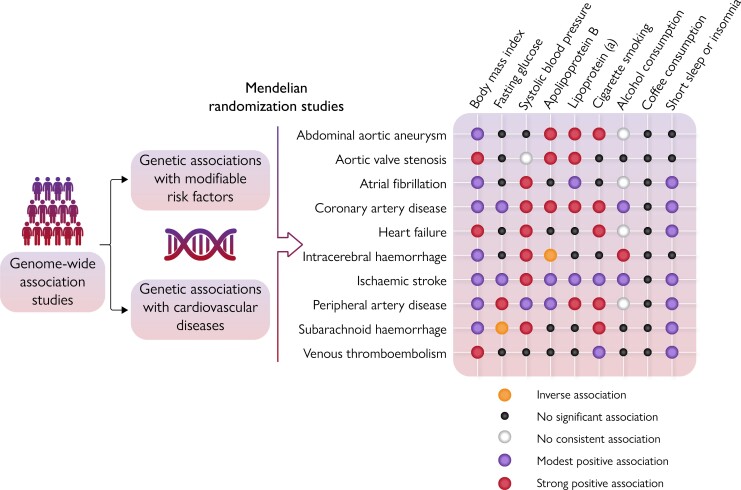Journal ID (nlm-ta): Eur Heart J
Journal ID (iso-abbrev): Eur Heart J
Journal ID (publisher-id): eurheartj
Title:
European Heart Journal
Publisher:
Oxford University Press
(US
)
ISSN
(Print):
0195-668X
ISSN
(Electronic):
1522-9645
Publication date Collection: 14
December
2023
Publication date
(Electronic):
03
November
2023
Publication date PMC-release: 03
November
2023
Volume: 44
Issue: 47
,
Focus Issue on Epidemiology, Prevention, and Health Care Policies
Pages: 4913-4924
Affiliations
Unit of Medical Epidemiology, Department of Surgical Sciences, Uppsala University , Uppsala, Sweden
Unit of Cardiovascular and Nutritional Epidemiology, Institute of Environmental Medicine,
Karolinska Institutet , Stockholm, Sweden
British Heart Foundation Cardiovascular Epidemiology Unit, Department of Public Health
and Primary Care, University of Cambridge , Cambridge, UK
Victor Phillip Dahdaleh Heart and Lung Research Institute, University of Cambridge , Papworth Road, Cambridge, UK
British Heart Foundation Centre of Research Excellence, School of Clinical Medicine,
Addenbrooke’s Hospital, University of Cambridge , Cambridge, UK
Health Data Research UK, Wellcome Genome Campus and University of Cambridge , Hinxton, UK
NIHR Blood and Transplant Research Unit in Donor Health and Behaviour, University
of Cambridge , Cambridge, UK
British Heart Foundation Cardiovascular Epidemiology Unit, Department of Public Health
and Primary Care, University of Cambridge , Cambridge, UK
Victor Phillip Dahdaleh Heart and Lung Research Institute, University of Cambridge , Papworth Road, Cambridge, UK
MRC Biostatistics Unit, University of Cambridge , Cambridge, UK
Author notes
Author information
Article
Publisher ID:
ehad736
DOI: 10.1093/eurheartj/ehad736
PMC ID: 10719501
PubMed ID: 37935836
SO-VID: 66ba51ee-86a0-4541-8729-52fd8cb425d9
Copyright © © The Author(s) 2023. Published by Oxford University Press on behalf of the European
Society of Cardiology.
License:
This is an Open Access article distributed under the terms of the Creative Commons
Attribution License (
https://creativecommons.org/licenses/by/4.0/), which permits unrestricted reuse, distribution, and reproduction in any medium,
provided the original work is properly cited.
Funded by:
Swedish Heart-Lung Foundation, DOI 10.13039/501100003793;
Funded by:
Hjärt-Lungfonden, DOI 10.13039/501100003793;
Award ID: 20190247
Funded by:
Swedish Research Council, DOI 10.13039/501100004359;
Funded by:
Vetenskapsrådet, DOI 10.13039/501100004359;
Award ID: 2019-00977
Funded by:
Swedish Cancer Society, DOI 10.13039/501100002794;
Funded by:
Wellcome Trust, DOI 10.13039/100010269;
Award ID: 225790/Z/22/Z
Funded by:
United Kingdom Research and Innovation Medical Research Council, DOI 10.13039/100014013;
Award ID: MC_UU_00002/7
Funded by:
National Institute for Health Research Cambridge Biomedical Research Centre, DOI 10.13039/501100000272;
Award ID: NIHR203312
Funded by:
NIHR Blood and Transplant Research Unit, DOI 10.13039/100009033;
Award ID: NIHR BTRU-2014-10024
Award ID: NIHR203337
Funded by:
UK Medical Research Council, DOI 10.13039/501100000690;
Award ID: MR/L003120/1
Funded by:
British Heart Foundation, DOI 10.13039/501100000274;
Award ID: SP/09/002
Award ID: RG/13/13/30194
Award ID: RG/18/13/33946
Funded by:
NIHR Cambridge BRC, DOI 10.13039/501100018956;
Award ID: BRC-1215-20014
Award ID: NIHR203312
Funded by:
EC-Innovative Medicines Initiative;
Funded by:
Health Data Research UK, DOI 10.13039/501100023699;
Funded by:
UK Medical Research Council, Engineering and Physical Sciences Research Council;
Funded by:
Economic and Social Research Council, DOI 10.13039/501100000269;
Funded by:
Department of Health and Social Care, DOI 10.13039/501100000276;
Funded by:
Chief Scientist Office of the Scottish Government Health and Social Care Directorates;
Funded by:
Health and Social Care Research and Development Division, DOI 10.13039/501100010756;
Funded by:
Public Health Agency, DOI 10.13039/501100001626;
Funded by:
British Heart Foundation and Wellcome;




